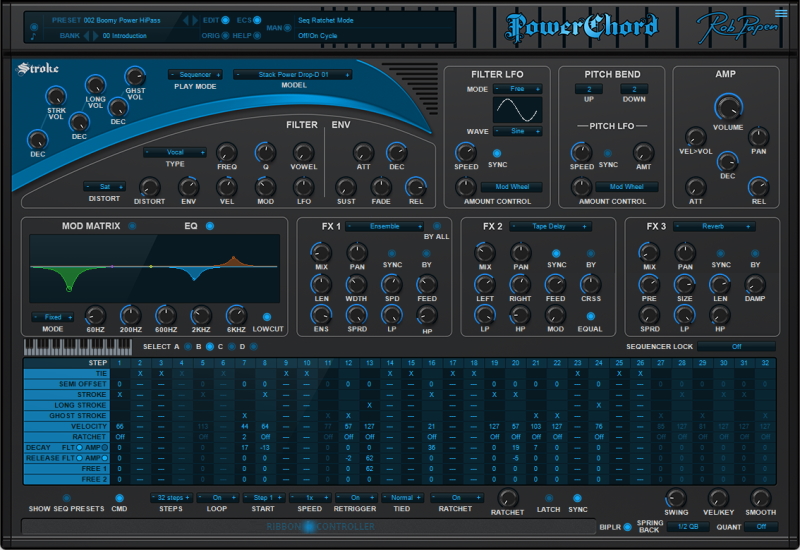Rob Papen PowerChord

Rob Papen Inspiration Soundware announces the availability of PowerChord as a unique guitar plug-in - permitting users to quickly create phenomenal power chord groove sequences utilising fanciful features that could conceivably leave some guitarists green with envy, even enhancing those grooves by making use of the plentiful presets available, or opting to manually play a STROKE, LONG STROKE, and GHOST STROKE - as of September 11…
“PowerChord is a unique guitar plug-in that allows you to create fantastic power chord grooves and lots more!” So, somewhat succinctly, says Rob Papen himself, perfectly positioned to introduce his namesake company’s latest offering to the technologically-minded musical masses. But before delving deeper, those not necessarily familiar with finding their way around a fretboard may well benefit from noting that a power chord - commonly known as a fifth chord - is a regularly used term for a chord played on an electric guitar that consists of the root note and the fifth, as well as, possibly, octaves of those notes, and are often played with an amp with intentionally added distortion or overdrive effects as a mainstay of many styles of rock. Rob Papen’s PowerChord is, therefore, about as perfectly named as it gets.
Get this, though, rather than relying on sampled loops, which can clearly be rather restrictive - not to mention repetitive - by their very nature, PowerChord users naturally find themselves actively engaging in an interactive experience that truly fosters creativity. Simply select Sequencer PLAY MODE to quickly create phenomenal power chord grooves with instant access to no fewer than 12 single solo guitar sounds - such as Grunge PowerChord; PowerChord; PowerChord Drop-A (tuning); PowerChord Drop-D; PowerNote (single notes); and RG PowerChord, the latter being the distortion sound of RG , Rob Papen’s similarly unique guitar plug-in for quickly creating classic rhythmic guitar grooves - and 41 stacked guitar model sounds utilising those solo guitar sounds. Being billed by its creator as a grunge guitar groove synthesizer, so-called groove sequences are created within PowerChord using four 32-step sequencers - namely, A, B, C, and D - selectable by keyboard range: MIDI Notes 36 C1 to 47 B1 play sequencer A; MIDI Notes 48 C2 to 59 B2 play sequencer B; MIDI Notes 60 C3 to 71 B3 play sequencer C; and MIDI Notes 72 C4 to 83 B4 play sequencer D. Fanciful features for each sequencer row include STEP (on/ off), SEMI OFFSET, STROKE, LONG STROKE, GHOST STROKE, VELOCITY, RATCHET, FLT (filter) DECAY/RELEASE, and AMP DECAY/RELEASE, plus FREE 1 and FREE 2. There are also sequencer controls for SWING, VEL/KEY, SMOOTH (for free rows), SPEED, RETRIGGER, TIED mode, and RATCHETING.
Additionally, all kinds of synthesizer-styled features are also on hand to assist PowerChord users with sculpting sounds still further... think analogue-modelled filters with 25 different character FILTER types, Ring modulation, and Amp modulation modes; MOD (modulation) MATRIX with eight slots; EQ with fixed (RG-style) EQ and five-band parametric with LOWCUT filter; three high-quality effects blocks - FX 1, FX 2, and FX 3 - arranged in serial mode with 34 effect types, including Amp Simulator (five models), AutoPan, AutoWah, Bass Enhancer, Cabinet Simulator (five models), Chorus, Chorus/Delay, Clipper, Comb Filter, Compressor, Distortion, Ensemble, Flanger, FX Filter, Gator, LoFi, Mono Delay, Multi- Distort (11 types), Noise Gate, Phaser, Reverb, Ring Modulator, Shift FX, Stereo Delay, Stereo Widener, TalkBox, Tape Chorus, Tape Delay, Tape Flanger, Tape Phase, Tremelo, WahWah, WahWah/Delay, and Waveshaper. All are audible in PowerChord’s plentiful presets, of course. And as if all that was not enough to be getting on with, MIDI (Musical Instrument Digital Interface) tempo-based settings are available in most effects, together with BY (bypass) per effect - not forgetting the welcomed inclusion of an overall effect bypass for full flexibility.
Familiarity for some comes courtesy of Rob Papen effectively transplanting the performance enhancing RIBBON CONTROLLER feature from BIT-2 - its critically-acclaimed analogue synthesis-modelled virtual instrument - into PowerChord, thereby allowing users to dynamically control several parameters at once using a mouse or external MIDI controllers; unlike a hardware ribbon controller, it also has a tempo-based SPRING BACK feature with QUANT (quantise) and BIPLR (bipolar) modes.
Meanwhile, Manual PLAY MODE makes it perfectly possible for more adventurous PowerChord users to manually play a STROKE, LONG STROKE, and GHOST STROKE, should they wish to do so. Says Rob Papen, ending on a well-thought-through high note that provides much in the way of food for thought in not too many words: “PowerChord will never replace a real guitarist, but, then again, a real guitarist can’t replace PowerChord due to the unique sounds it can create!” Indeed, it is even possible that those quickly-created phenomenal power chord groove sequences could conceivably leave some guitarists green with envy.
PowerChord is available as a 64-bit AAX-, AU-, VST- and VST3-compatible virtual instrument plug-in for Mac (OS X 10.15 or higher, M1/M2/M3 ARM processor compatible) and as a 64-bit VST- and VST3-compatible virtual instrument plug-in for PC (Windows 7 or higher) - with 64-bit AAX compatibility available for PT 12 or higher (PC) - priced at an attractive introductory promo price of €65.00 EUR/$65.00 USD until September 17, 2024 - rising thereafter to its regular price of €79.00 EUR/$79.00 USD - from authorised Rob Papen resellers worldwide or as a download directly from Rob Papen itself for the same pricing. PowerChord is included in the latest version of Rob Papen’s all-encompassing eXplorer-9 bundle at no additional cost, so existing owners only have to download the latest installer and run it to add PowerChord to their Rob Papen virtual instrument and effect plug-in collection.
 How to resolve AdBlock issue?
How to resolve AdBlock issue?